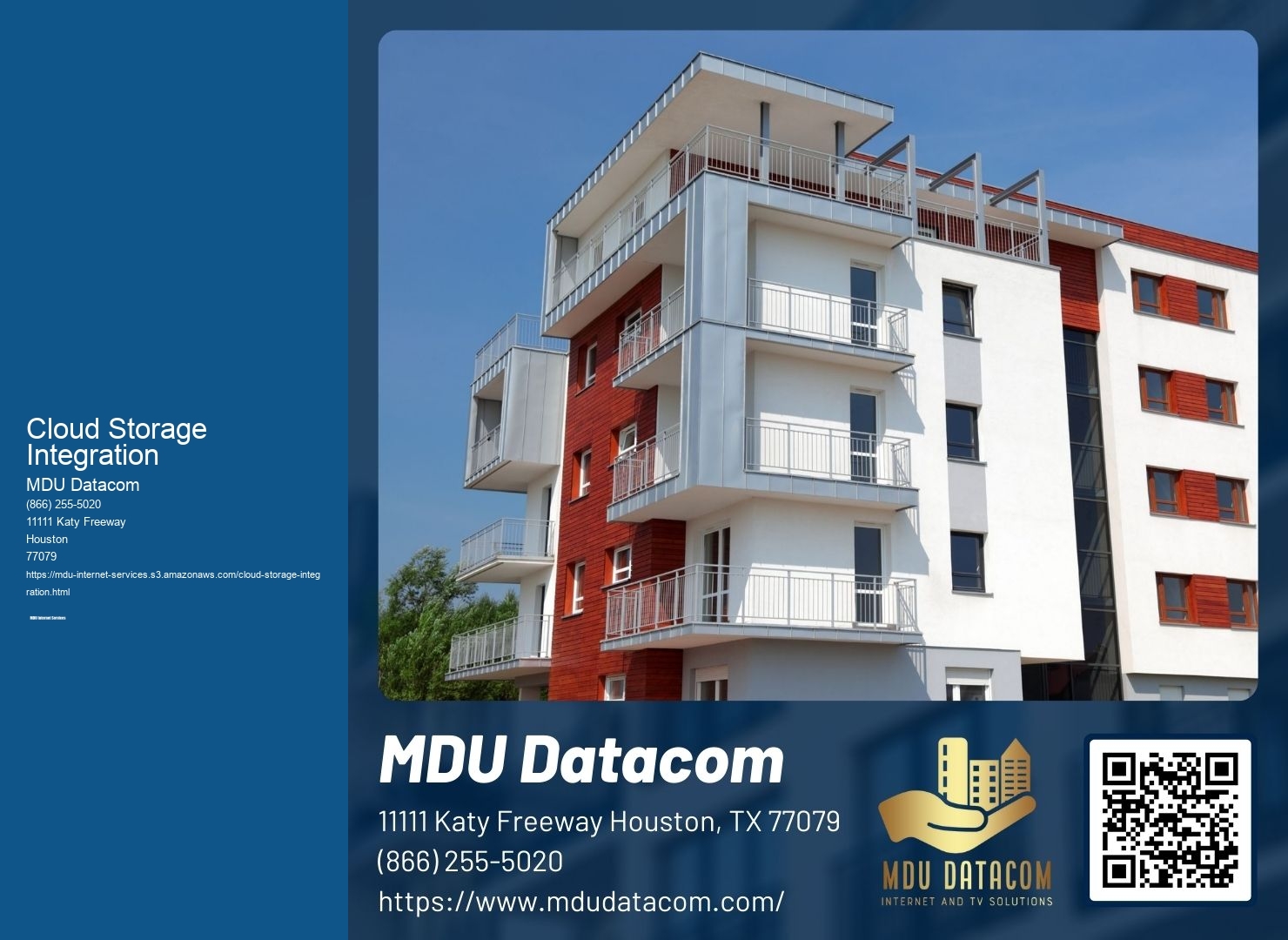

Cloud storage integration with popular productivity tools like Microsoft Office and Google Docs allows users to seamlessly save and access their files directly from within these applications. This integration typically involves linking the user's cloud storage account to the productivity tool, enabling them to save their documents, spreadsheets, and presentations directly to the cloud. Residential Complex Internet Services Users can also open files stored in the cloud directly from the productivity tool, making it easier to collaborate on documents and access files from different devices. This integration enhances productivity by eliminating the need to manually save and transfer files between the productivity tool and cloud storage.
Integrating cloud storage with project management software offers several benefits.
Yes, cloud storage integration can greatly streamline the process of sharing and collaborating on files within a team. By integrating cloud storage with collaboration tools, team members can easily share files with each other, eliminating the need for email attachments or manual file transfers. Cloud storage integration also enables real-time collaboration, allowing multiple team members to work on the same document simultaneously. This enhances productivity and reduces the time spent on file sharing and collaboration. Additionally, cloud storage integration often includes features such as version control and commenting, making it easier for team members to track changes and provide feedback on shared files.
Property Internet Solutions
Cloud storage integration ensures data security and privacy through various measures. Firstly, reputable cloud storage providers employ robust encryption techniques to protect data during transmission and storage. This ensures that files stored in the cloud are secure from unauthorized access. High-Speed Internet for Multi-Dwelling Units Additionally, cloud storage integration often includes features such as access controls and permissions, allowing users to define who can view, edit, or share their files. This helps prevent unauthorized access and ensures that sensitive information is only accessible to authorized individuals. Cloud storage providers also implement regular security audits and updates to maintain the integrity and confidentiality of stored data.
Setting up cloud storage integration with a website or application typically involves several steps. Firstly, the website or application needs to establish a connection with the chosen cloud storage provider's API (Application Programming Interface). Bulk Internet Access for Apartments This involves obtaining API credentials and configuring the integration settings. Next, the website or application needs to implement the necessary code to handle file uploads, downloads, and other interactions with the cloud storage provider's API. This may involve using software development frameworks or libraries specific to the chosen cloud storage provider. Finally, the integration needs to be tested thoroughly to ensure that files can be successfully uploaded, downloaded, and accessed from the cloud storage provider.

Cloud storage integration can automate data backup and recovery processes by leveraging the cloud provider's built-in backup and recovery features. By integrating with cloud storage, websites or applications can automatically back up their data to the cloud at regular intervals or in real-time. This ensures that data is protected from hardware failures, natural disasters, or other unforeseen events. In the event of data loss or corruption, cloud storage integration allows for easy and efficient data recovery by restoring the backed-up files from the cloud. This automation eliminates the need for manual backups and simplifies the data recovery process, saving time and effort for website or application owners.
When integrating multiple cloud storage providers, there may be limitations or compatibility issues to consider. Different cloud storage providers may have varying APIs, authentication methods, and feature sets, which can impact the integration process. It is important to ensure that the chosen cloud storage providers are compatible with the website or application's technology stack and programming language. Additionally, some cloud storage providers may have restrictions on the number of API requests or the amount of data that can be transferred, which can affect the performance and scalability of the integration. It is crucial to thoroughly research and test the compatibility and limitations of each cloud storage provider before integrating them into a website or application.

MDU internet services, also known as Multi-Dwelling Unit internet services, may or may not have data caps depending on the specific provider and package chosen. Data caps refer to the limit on the amount of data that can be used within a given billing cycle. Some MDU internet services may have data caps in place to manage network congestion and ensure fair usage among multiple users within the same building or complex. However, it is important to note that not all MDU internet services have data caps, as some providers offer unlimited data plans. When considering MDU internet services, it is advisable to carefully review the terms and conditions, as well as the specific package details, to determine if there are any data caps or restrictions in place.
MDU (Multi-Dwelling Unit) ensures internet reliability during peak usage times by implementing various strategies and technologies. One of the key approaches is the use of load balancing techniques, which distribute the network traffic evenly across multiple servers or connections. This helps to prevent any single server or connection from becoming overwhelmed and ensures a consistent and reliable internet experience for users. Additionally, MDU may employ traffic shaping and prioritization techniques to allocate bandwidth resources efficiently. By prioritizing critical applications and limiting bandwidth for non-essential activities, MDU can optimize network performance and minimize disruptions during peak usage periods. Furthermore, MDU may invest in robust infrastructure, such as fiber-optic cables, to provide high-speed and reliable internet connectivity. This advanced technology allows for greater bandwidth capacity and faster data transmission, reducing the likelihood of congestion and ensuring a reliable internet connection even during peak usage times.
MDU, or Multiple Dwelling Unit, typically handles requests for internet service upgrades in older apartment buildings with outdated infrastructure by conducting a thorough assessment of the existing infrastructure and identifying the areas that require improvement. This assessment includes evaluating the wiring, cabling, and networking equipment in the building to determine the extent of the upgrades needed. Once the assessment is complete, MDU may employ various strategies such as rewiring, installing new networking equipment, or upgrading the existing infrastructure to ensure a seamless and efficient internet service. Additionally, MDU may collaborate with internet service providers to leverage advanced technologies like fiber-optic cables or wireless networks to enhance the internet connectivity in these older buildings. By employing these strategies, MDU aims to provide residents with faster and more reliable internet service, despite the challenges posed by outdated infrastructure.
Residents of MDU (multi-dwelling unit) internet services can indeed request priority access for specific online services or applications. With the increasing demand for high-speed internet and the proliferation of various online services, MDU providers understand the need for customized internet experiences. By prioritizing access to specific services or applications, residents can enjoy seamless streaming, gaming, or other online activities without any interruptions or latency issues. This prioritization can be achieved through advanced traffic management techniques, such as Quality of Service (QoS) protocols, which allocate bandwidth and prioritize certain types of traffic over others. Additionally, MDU providers may offer service plans that cater to specific online activities, allowing residents to choose packages that prioritize their preferred services or applications.
MDU (Multi-Dwelling Unit) ensures equitable internet access for all residents within a multi-family property by implementing various strategies and technologies. Firstly, they deploy fiber-optic cables, which provide high-speed and reliable internet connectivity to all units. Additionally, they install Wi-Fi access points strategically throughout the property to ensure seamless coverage in all areas. To further enhance accessibility, MDU may also offer multiple internet service providers (ISPs) to residents, allowing them to choose the provider that best suits their needs. Moreover, MDU may implement bandwidth management systems to ensure fair distribution of internet resources among residents, preventing any single user from monopolizing the network. By employing these measures, MDU ensures that all residents have equal and fair access to high-quality internet services within the multi-family property.
Yes, MDU does offer managed Wi-Fi services for property management companies. As a leading provider in the industry, MDU understands the unique needs of property management companies when it comes to Wi-Fi services. They offer a comprehensive range of managed Wi-Fi solutions that are specifically designed to meet the demands of multi-dwelling units. These services include installation, maintenance, and support for Wi-Fi networks, as well as advanced features such as guest access, bandwidth management, and security protocols. With MDU's managed Wi-Fi services, property management companies can ensure that their residents have reliable and high-speed internet connectivity, enhancing the overall living experience in their properties.
When it comes to streaming quality or resolution with MDU internet services, there may be certain limitations to consider. These limitations can vary depending on factors such as the specific MDU internet provider, the type of internet connection being used (e.g., fiber optic, cable, DSL), and the package or plan chosen by the customer. Some MDU internet services may offer different tiers or levels of service, each with its own maximum streaming quality or resolution. For example, a basic package may only support streaming in standard definition (SD), while a higher-tier package may allow for streaming in high definition (HD) or even ultra-high definition (UHD). Additionally, the overall bandwidth and network congestion can also impact streaming quality, especially during peak usage times. It is important for customers to review the details of their chosen MDU internet service and plan to understand any potential limitations on streaming quality or resolution.